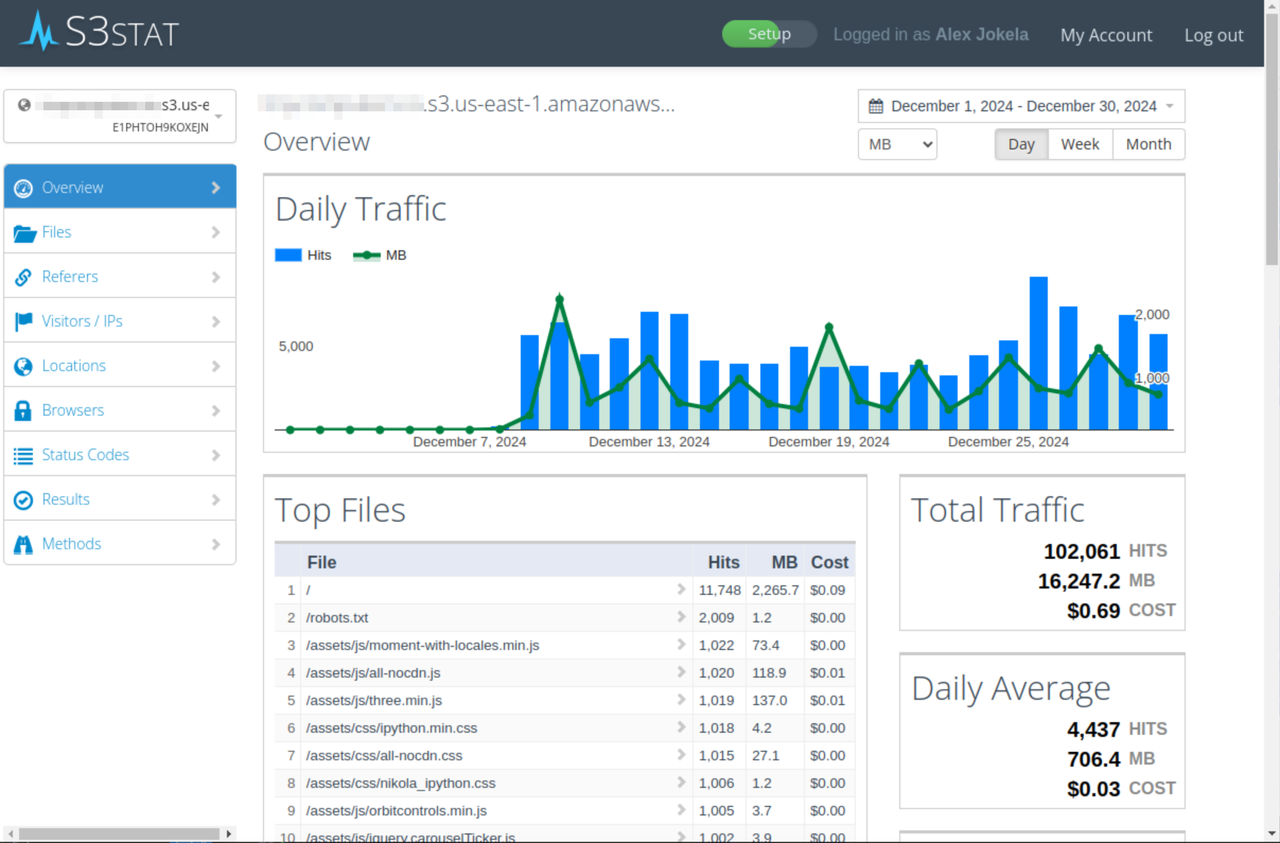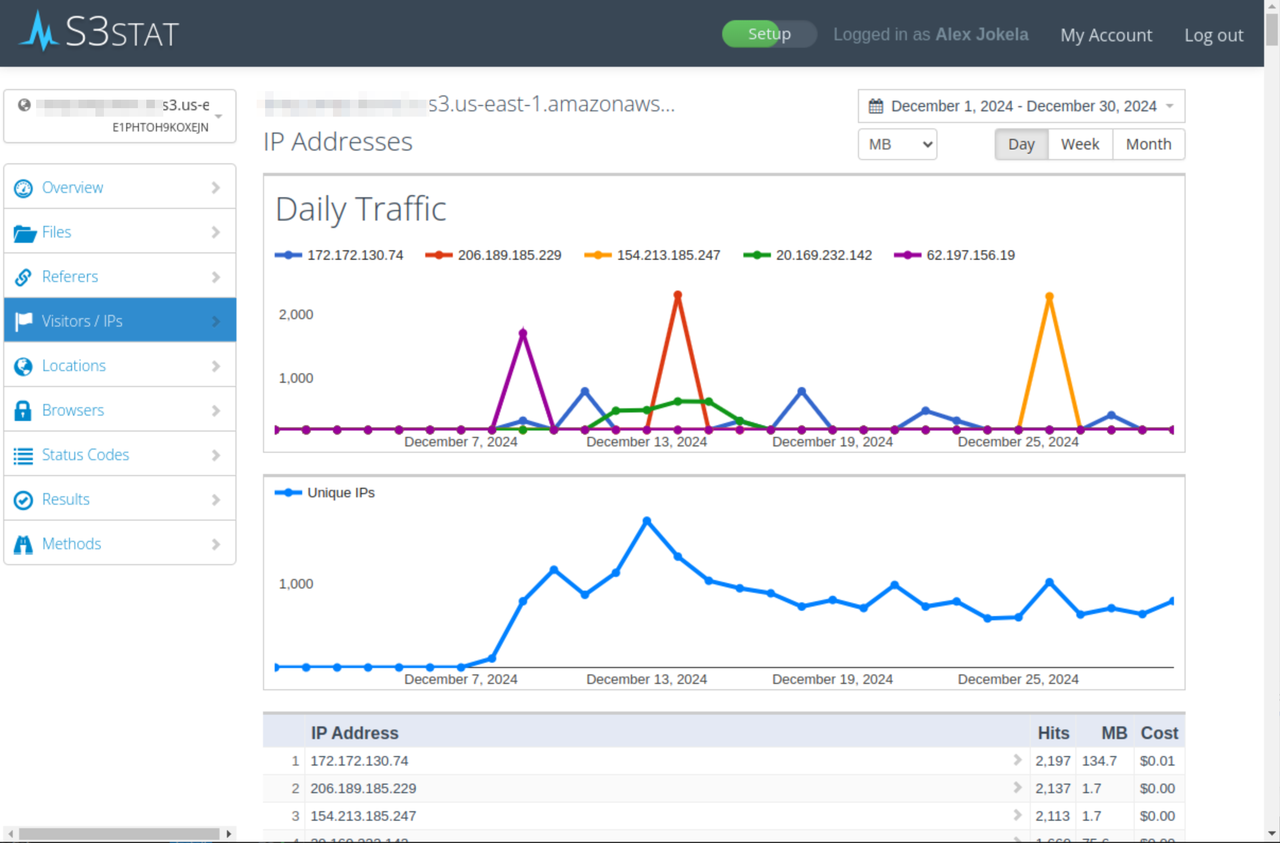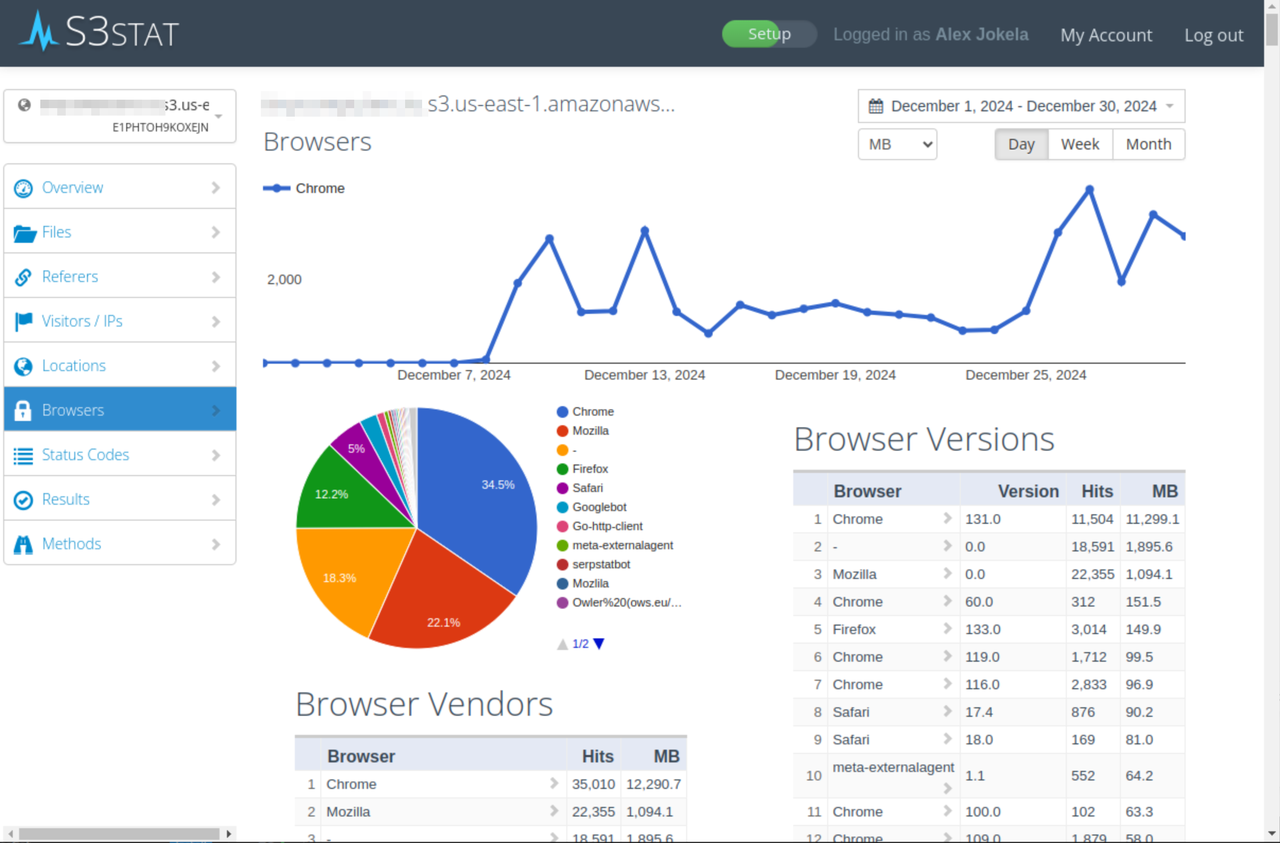
S3STAT is a powerful tool designed to analyze Amazon S3 bucket usage patterns, providing valuable insights into traffic patterns, error rates, and geographic distribution. Its primary purpose is to help users optimize their S3 bucket performance, improve security, and reduce costs. By utilizing S3STAT, users can gain a deeper understanding of how their S3 buckets are being accessed and utilized, allowing them to make informed decisions about their cloud storage infrastructure. The benefits of using S3STAT are numerous, including the ability to identify and troubleshoot issues quickly, optimize content delivery for global audiences, and detect potential security threats. Overall, S3STAT is an essential tool for anyone looking to unlock the full potential of their Amazon S3 buckets and ensure they are running efficiently and effectively. With its robust features and ease of use, S3STAT has become a go-to solution for many organizations seeking to optimize their cloud storage operations.
Getting started with S3STAT is a straightforward and easy process, requiring minimal effort and technical expertise. The setup process is well-documented by S3STAT, with clear and concise instructions that guide users through each step, ensuring a seamless experience. Additionally, S3STAT requires only minimal permissions to function, making it a secure and low-risk addition to any Amazon S3 infrastructure. Overall, the ease of use for getting started with S3STAT is one of its most significant advantages, allowing users to quickly and easily begin analyzing their S3 bucket usage patterns and gaining valuable insights into their cloud storage operations.
S3STAT provides a comprehensive range of reports that offer in-depth insights into Amazon S3 bucket usage patterns. The reports include detailed information on traffic patterns and bandwidth usage, allowing users to understand how their S3 buckets are being accessed and utilized over time. This information can be used to identify peak usage periods, optimize content delivery, and reduce costs by optimizing storage and data transfer. Additionally, S3STAT reports provide error rates and access denied messages, enabling users to quickly identify and troubleshoot issues with their S3 buckets, such as permissions problems or corrupted files.

The geographic distribution report provides a detailed breakdown of where traffic is coming from, allowing users to understand their global reach and optimize content delivery for different regions. The user agent analysis report provides information on the types of devices and browsers being used to access S3 buckets, enabling users to tailor their content and optimize their applications for specific platforms. By analyzing these reports, users can gain a deeper understanding of their S3 bucket usage patterns and make informed decisions about how to optimize their cloud storage infrastructure.
For example, by analyzing traffic patterns and bandwidth usage, a user may discover that their S3 bucket is experiencing high levels of traffic during certain hours of the day, and adjust their content delivery strategy accordingly. Similarly, by examining error rates and access denied messages, a user may identify a permissions issue that is preventing users from accessing certain files, and take corrective action to resolve the problem. By leveraging the insights provided by S3STAT reports, users can optimize their S3 bucket performance, improve security, and reduce costs, ultimately leading to more efficient and effective cloud storage operations. Furthermore, the detailed information provided by S3STAT reports enables users to refine their strategies over time, making data-driven decisions that drive business success.
S3STAT provides a detailed analysis of traffic patterns, allowing users to gain a deeper understanding of how their Amazon S3 buckets are being accessed and utilized. One key aspect of this analysis is the breakdown of request types, including GET, PUT, DELETE, and other operations. By examining these request types, users can identify trends and patterns in how their S3 buckets are being used, such as whether they are primarily being used for storing and retrieving files, or if they are being used for more complex operations like data processing and analysis.
In addition to request types, S3STAT also provides detailed information on data transfer volumes and bandwidth usage. This information can be used to identify peak usage periods, optimize content delivery, and reduce costs by optimizing storage and data transfer. For example, if a user notices that their S3 bucket is experiencing high levels of traffic during certain hours of the day, they may be able to adjust their content delivery strategy to take advantage of lower-cost storage options during off-peak hours.
 S3STAT also provides time of day and day of week analysis, allowing users to understand how their S3 bucket usage patterns vary over time. This information can be used to optimize S3 bucket performance and reduce costs by identifying opportunities to cache frequently accessed content, use Content Delivery Networks (CDNs) to distribute content more efficiently, or adjust storage class and retention policies to match changing usage patterns. For instance, if a user notices that their S3 bucket is experiencing high levels of traffic on weekdays but low levels of traffic on weekends, they may be able to adjust their storage class and retention policies to take advantage of lower-cost options during periods of low usage.
S3STAT also provides time of day and day of week analysis, allowing users to understand how their S3 bucket usage patterns vary over time. This information can be used to optimize S3 bucket performance and reduce costs by identifying opportunities to cache frequently accessed content, use Content Delivery Networks (CDNs) to distribute content more efficiently, or adjust storage class and retention policies to match changing usage patterns. For instance, if a user notices that their S3 bucket is experiencing high levels of traffic on weekdays but low levels of traffic on weekends, they may be able to adjust their storage class and retention policies to take advantage of lower-cost options during periods of low usage.
By analyzing this data, users can optimize their S3 bucket performance and reduce costs in a variety of ways. For example, they may be able to identify opportunities to use Amazon S3's Infrequent Access storage class, which provides a lower-cost storage option for data that is not frequently accessed. They may also be able to use Amazon S3's lifecycle policies to automatically transition data to lower-cost storage classes or delete it after a certain period of time. Additionally, users can use this data to optimize their content delivery strategy, such as by using CDNs to distribute content more efficiently or caching frequently accessed content to reduce the number of requests made to their S3 bucket.
Furthermore, analyzing traffic patterns with S3STAT can also help users identify potential security risks and take proactive measures to mitigate them. For instance, if a user notices unusual patterns of access or high levels of traffic from unknown sources, they may be able to take steps to secure their S3 bucket and prevent unauthorized access. By leveraging the detailed insights provided by S3STAT, users can optimize their S3 bucket performance, reduce costs, and improve security, ultimately leading to more efficient and effective cloud storage operations. With this level of visibility and control, users can make data-driven decisions that drive business success and ensure the long-term health and security of their Amazon S3 infrastructure.
S3STAT provides valuable geographic insights into where your Amazon S3 traffic is coming from, allowing you to understand your global reach and optimize content delivery for different regions. By analyzing the geographic distribution of your S3 traffic, you can identify areas with high demand and adjust your content delivery strategy accordingly. For example, if you notice that a significant portion of your traffic is coming from Europe, you may want to consider using Amazon S3's European data centers or partnering with a Content Delivery Network (CDN) that has a strong presence in the region. This can help reduce latency and improve the overall user experience for your global audience.
In addition to geographic analysis, S3STAT also provides error analysis capabilities that help identify issues with S3 requests, including 404 errors, access denied messages, timeouts, and other connection issues. By analyzing this data, you can quickly troubleshoot and resolve problems, reducing downtime and improving the overall reliability of your S3-based applications and services. For example, if you notice a high volume of 404 errors coming from a specific region, you may want to investigate whether there are issues with your DNS configuration or if there are problems with your content being cached incorrectly.
 To troubleshoot and resolve problems quickly, you can use S3STAT's error analysis data to identify patterns and trends in your S3 request logs. For instance, you may notice that a particular type of error is occurring frequently during peak hours, indicating a potential issue with your application's scalability or performance under load. By using this data to inform your troubleshooting efforts, you can quickly identify the root cause of problems and take corrective action to prevent them from happening in the future. This can help reduce the mean time to detect (MTTD) and mean time to resolve (MTTR) issues, ultimately leading to improved uptime and increased customer satisfaction.
To troubleshoot and resolve problems quickly, you can use S3STAT's error analysis data to identify patterns and trends in your S3 request logs. For instance, you may notice that a particular type of error is occurring frequently during peak hours, indicating a potential issue with your application's scalability or performance under load. By using this data to inform your troubleshooting efforts, you can quickly identify the root cause of problems and take corrective action to prevent them from happening in the future. This can help reduce the mean time to detect (MTTD) and mean time to resolve (MTTR) issues, ultimately leading to improved uptime and increased customer satisfaction.
S3STAT provides valuable insights into who is accessing your Amazon S3 objects, allowing you to monitor and control access to your sensitive data. By analyzing the access logs, you can identify patterns and trends in user behavior, detect potential security threats, and take proactive measures to prevent unauthorized access.
With S3STAT, you can use this data to detect potential security threats such as:
- Unusual access patterns or locations
- Access attempts from unknown or untrusted IP addresses
- Multiple failed login attempts
You can also use this data to take proactive measures to prevent unauthorized access, such as:
- Implementing bucket policies and access control lists (ACLs) to restrict access to sensitive data
- Enabling versioning and object locking to prevent accidental or malicious deletion of objects
- Configuring S3 to send notifications when certain events occur, such as when an object is accessed or modified
Additionally, S3STAT's security insights can help you comply with regulatory requirements and industry standards for data access and security. By monitoring and controlling access to your S3 objects, you can ensure the integrity and confidentiality of your sensitive data and maintain the trust of your customers and stakeholders.
To maximize your insights with S3STAT, follow these best practices:
- Regularly review reports and analyze data: Schedule regular reviews of your S3STAT reports to stay on top of trends, patterns, and anomalies in your S3 usage.
- Use data to inform decisions about S3 bucket optimization and performance: Use S3STAT's insights to optimize your S3 bucket configuration, such as adjusting storage classes, lifecycle policies, and caching strategies.
- Integrate with other AWS services: Combine S3STAT data with other AWS services, like CloudWatch and CloudTrail, to gain a more comprehensive understanding of your AWS usage and performance.
- Monitor and adjust: Continuously monitor your S3STAT data and adjust your optimization strategies as needed to ensure optimal performance, security, and cost-effectiveness.
By following these best practices, you can unlock the full potential of S3STAT and make data-driven decisions to optimize your Amazon S3 usage, improve performance, and reduce costs. Regular review and analysis of S3STAT data will help you identify areas for improvement and ensure that your S3 buckets are running efficiently and securely.
S3STAT is a powerful tool that provides unparalleled insights into your Amazon S3 bucket usage patterns. With its ease of use and comprehensive reporting capabilities, S3STAT makes it simple to unlock the full potential of your S3 buckets. By leveraging S3STAT's analytics and monitoring features, you can optimize performance, enhance security, and reduce costs. Whether you're looking to improve data transfer speeds, detect potential security threats, or streamline your storage infrastructure, S3STAT has got you covered. With its ability to provide detailed insights into your S3 usage patterns, S3STAT is an essential tool for any organization looking to get the most out of their Amazon S3 investment. By using S3STAT, you can make data-driven decisions and take your S3 bucket management to the next level, ensuring optimal performance, security, and cost-effectiveness.
